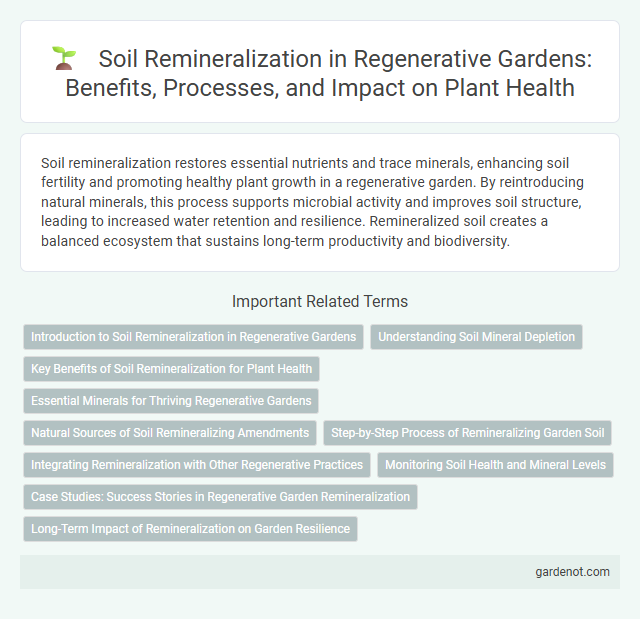Soil remineralization restores essential nutrients and trace minerals, enhancing soil fertility and promoting healthy plant growth in a regenerative garden. By reintroducing natural minerals, this process supports microbial activity and improves soil structure, leading to increased water retention and resilience. Remineralized soil creates a balanced ecosystem that sustains long-term productivity and biodiversity.
Introduction to Soil Remineralization in Regenerative Gardens
Soil remineralization in regenerative gardens enhances nutrient cycling by replenishing essential minerals depleted through intensive cultivation. This process improves soil structure, water retention, and microbial activity, fostering healthier plant growth and increased biodiversity. Incorporating natural rock dusts and mineral-rich composts restores soil fertility while supporting long-term ecosystem resilience.
Understanding Soil Mineral Depletion
Soil mineral depletion occurs when essential nutrients like calcium, magnesium, potassium, and trace elements are extracted from the soil faster than they are naturally replenished, leading to reduced fertility and compromised plant health. Intensive farming practices, erosion, and lack of organic matter contribute significantly to the loss of vital minerals necessary for microbial activity and plant nutrient uptake. Recognizing the patterns of mineral depletion allows regenerative gardeners to implement soil remineralization techniques, such as applying rock dusts, compost, and mineral-rich amendments, to restore soil balance and promote sustainable plant growth.
Key Benefits of Soil Remineralization for Plant Health
Soil remineralization enhances plant health by restoring essential minerals like calcium, magnesium, and potassium, which improve nutrient uptake and boost photosynthesis. This process increases soil fertility and microbial activity, leading to stronger plant root systems and greater resistance to pests and diseases. Improved soil structure from remineralization promotes better water retention and aeration, essential for optimal plant growth and resilience.
Essential Minerals for Thriving Regenerative Gardens
Soil remineralization replenishes essential minerals like calcium, magnesium, potassium, and trace elements vital for nutrient cycling and plant health in regenerative gardens. These minerals enhance soil structure, water retention, and microbial activity, promoting resilient, high-yield ecosystems. Maintaining balanced mineral levels supports diverse plant growth, carbon sequestration, and long-term soil fertility.
Natural Sources of Soil Remineralizing Amendments
Natural sources of soil remineralizing amendments include rock dust, basalt, glacial rock flour, and ancient sea sediments, which supply essential trace minerals like calcium, magnesium, potassium, and iron. Organic materials such as composted plant residues, biochar, and seaweed extracts also contribute to replenishing soil mineral content while enhancing microbial activity. Using these natural inputs promotes soil fertility, improves plant nutrient uptake, and supports long-term regenerative garden health.
Step-by-Step Process of Remineralizing Garden Soil
Soil remineralization begins with a comprehensive soil test to identify nutrient deficiencies and pH imbalances, guiding the selection of appropriate mineral amendments such as rock dust, crushed granite, or glacial rock flour. The chosen minerals are evenly distributed over the garden beds and worked into the topsoil to enhance microbial activity and improve soil structure. Regular application every 2-3 years supports long-term nutrient availability, promoting healthy plant growth and increasing soil fertility in regenerative gardens.
Integrating Remineralization with Other Regenerative Practices
Integrating soil remineralization with cover cropping and compost application enhances nutrient cycling and microbial activity, promoting healthy soil structure and fertility. Combining rock dust amendments with biochar improves cation exchange capacity and water retention, supporting plant resilience and growth. Coordinated implementation of remineralization and no-till farming maintains soil organic matter while replenishing essential minerals for sustained regenerative garden productivity.
Monitoring Soil Health and Mineral Levels
Monitoring soil health and mineral levels involves regular soil testing to assess nutrient availability, pH balance, and microbial activity essential for plant growth. Implementing digital tools and sensors allows precise tracking of soil mineral content, enabling targeted remineralization strategies that enhance soil structure and fertility. Consistent evaluation supports the sustainable restoration of vital minerals like calcium, magnesium, and potassium, promoting resilient and productive regenerative gardens.
Case Studies: Success Stories in Regenerative Garden Remineralization
Case studies in regenerative garden remineralization demonstrate remarkable improvements in soil health, plant vigor, and crop yields through the application of mineral-rich rock dust and natural amendments. Farms integrating basalt rock powder and sea minerals report enhanced microbial activity, increased nutrient retention, and restored soil structure within one growing season. Notable examples include the Rodale Institute trials and New Zealand's Kaeo Forest Gardens, where soil remineralization practices led to sustainable productivity and resilience against climate stress.
Long-Term Impact of Remineralization on Garden Resilience
Soil remineralization enhances garden resilience by restoring essential minerals like calcium, magnesium, and potassium, which improve soil structure and nutrient availability. This process boosts microbial activity and water retention, reducing erosion and plant stress during droughts or heavy rains. Over time, remineralized soils support healthier, more robust plants with greater resistance to pests and diseases.
Soil remineralization Infographic

 gardenot.com
gardenot.com